- After six months of poor export volumes, coffee trading is warming up in Brazil. With more volume on offer, it should be easier for roasters to source the coffees they need with more room to talk prices. It’s a buyers’ market.
- Dry weather is favourable to quality. Post-harvest is not being delayed or compromised by rains, coffee beans are showing good screen size distribution and there are no reports of diseases. Expect good grades and cup scores.
- The C-market became more liquid as prices dropped in July. Lower outputs in Colombia, Indonesia and Vietnam are keeping prices from falling off a cliff but organisations in Brazil signal that international traders are overly reliant on the country’s production.
- Production costs are starting to drop with the exception of labour expenses. Producers are adjusting to new price dynamics and should be more willing to negotiate. The silver lining is that there should be more room for communication with buyers moving forward.
July 27 Update
Brazilian news outlets report that coffee farmers are satisfied with the quality of the season's coffee but production volume is below what was projected at the beginning of the harvest.
The arrival of heatwaves related to the El Niño phenomenon around the globe is also creating apprehension and producers are being cautious with sales.
El Niño poses a threat to the rain regimen in Brazil in the second half of 2023 and early 2024, a critical period that will determine the productivity of the next harvest cycle (2024/25).
Minas Gerais has had a dry week, contributing to the good progress of the harvest. Seasonality tends to push prices down, but the recovery of the Brazilian real against the dollar, limited stocks certified by ICE and concerns about El Niño are supporting prices, preventing a steeper decline.
A Slow Start to the 2023 Season
The Brazilian coffee market was moving at a sluggish pace until early July. The harvest itself is only delayed in some areas and we already have some fresh crop samples in stock. But, in general, not a lot was being bought or sold according to the producers and exporters we spoke to.
To some extent, that’s normal. Things tend to move slower from May to June, the first months of the harvest season before the fear of frost clears out. However Brazilian exports in the first half of the year were down 18% from last year. And the lack of domestic stocks is not enough to explain that.
 Cooperatives and exporters have been uneasy with the pace of sales (Photo: Algrano)
Cooperatives and exporters have been uneasy with the pace of sales (Photo: Algrano)
If 2021 and 2022 were dominated by problems with supply and logistics, in 2023 we’re feeling the impact of rising labour costs, war-driven inflation and slowdown of economic activity in the buying North. The struggle has passed onto the demand side. With that, prices dropped.
The impacts of a potential recession in buying countries are deeply concerning to producers and exporters, who worry buyers might be already carrying too much stock in a scenario of reduced consumer demand.
At the same time, the new market dynamics mean that trading is picking up, albeit at lower prices than most farmers would like.
“At least so far, with no risk of intense cold in coffee growing regions, with the weather supporting the good progress of harvesting work in Brazil, and with the high cost of credit in the face of high-interest rates, it is evident that buyers choose to stay on the sidelines, waiting for the arrival of coffees from the 2023/24 harvest. There is no reason, in the current scenario, for buyers to work with high levels of stock,” wrote Procafé Foundation this July.
An Inverted Coffee Market
The director of exporting company Itah, Roberta Rossi, also pointed out to us that everyone in Brazil, from large traders to cooperatives, was going to continue trading very little until “the price parameters return to normality”.
By price parameters, she refers to the gap between the cost of contracts for immediate or near-term delivery and long-term delivery. And this started happening in July, now that the c-price dropped below 160 cents/lb, closer to the December and March contracts.
Until early July, what we saw was an “inverted” market. That’s when the price of coffee for future delivery is lower than the price for immediate or near-term delivery. Normally, the price of a commodity for future delivery tends to be higher to account for storage costs, interest, and risk.
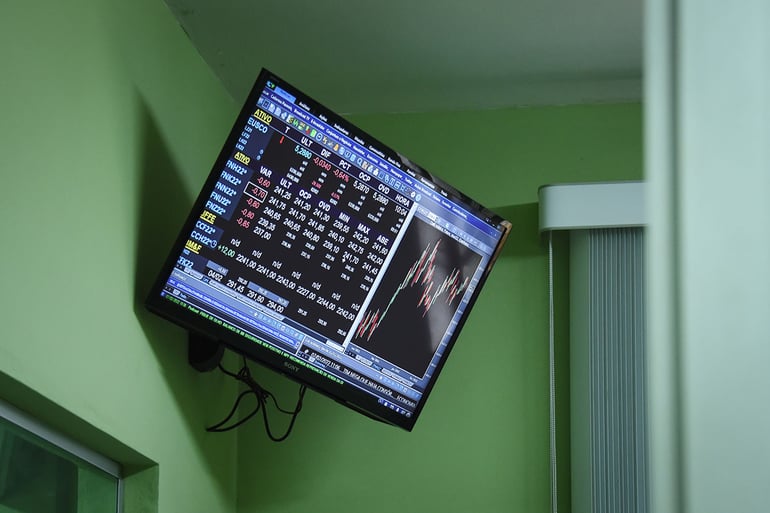
Following price movements in real-time at the offices of Coopervass, MG (Photo: Algrano)
An inverted market suggests that buyers expect a shortage of coffee in the future. Low outputs in Colombia, Vietnam’s lowest harvest in four years and significantly smaller volumes from Indonesia are realities that support that. But news of the good weather in Brazil is a significant balancing factor. Or, at least, traders and speculators seem to think so.
It’s no wonder that Escritório Carvalhaes, a traditional trading house in Santos, wrote that “Market operators and large international roasters continue to bet that the new Brazilian crop of 2023 will solve the supply problems of coffee industries around the world single-handedly”.
 Dry weather and a return of productivity boost the mood on the ground (Photo: Capeca)
Dry weather and a return of productivity boost the mood on the ground (Photo: Capeca)
Nonetheless, There Is Optimism in Brazil
Despite the recent price drop, the new harvest is bringing more optimism for Brazilian producers. That’s based on recovering plots, new trees coming into production, and a better volume and quality.
According to Allan Brotel, Business Development at Sancoffee in Campo das Vertentes, the last couple of years were met with frustration because of the country’s low outputs since the 2021 frost.
He explains Brazil was going through an “incredible phase” up until 2020, with good productivity and favourable weather conditions.
Having been forced to stump many trees or do corrective pruning meant that there wasn’t as much coffee to sell when prices went up.
Allan compares this to roasters’ wholesale customers closing doors during the pandemic and affecting their possibilities to earn money.
Heron Reger de Carvalho Junior of Fazenda Canta Galo, also Campos Altos, said many farmers, himself included, never got to sell a sack of coffee at the peak price of RS$ 1,500.00 (around US$ 300.00) in 2022 because there was no coffee left to sell.
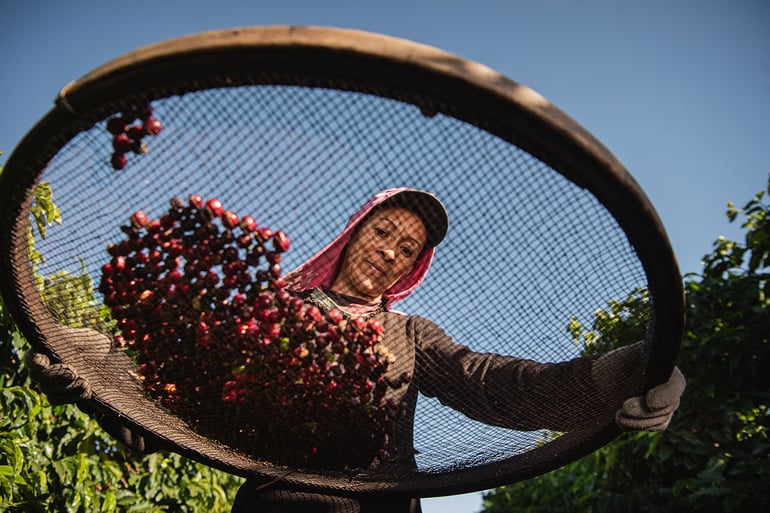
The sunny weather promises good quality for this year's coffee (Photo: Sancoffee)
All producers we spoke to for this report say that they’re seeing a good distribution of screen size with lots of screens 17 and 18 and that overall quality looks promising.
There have been isolated cases of rain after cherries were taken to dry on patios, something that leads to unwanted fermentation. Overall, the weather is dry in Minas Gerais.
No one reported cases of Coffee Berry Borer disease and cherries are well distributed across plantations.
In 2022, when coffee plants were not yet recovered from the frost, farms looked like patchwork. There would be plants loaded with coffee cherries next to others with virtually no fruit, making it harder to plan where to send harvesters first.
Rafael Vinhal of Vinhal Cafés Artesanais also says his “cherry window” is looking good. The window is the period of time it takes for coffee cherries to go from green to ripe and then overripe.
He explains this can happen very fast. And when it happens to one farm in the area, it usually happens to them all. A short cherry window means that farmers might miss the optimum ripeness stage on some plots if they only have one harvester, which is Rafael’s case.
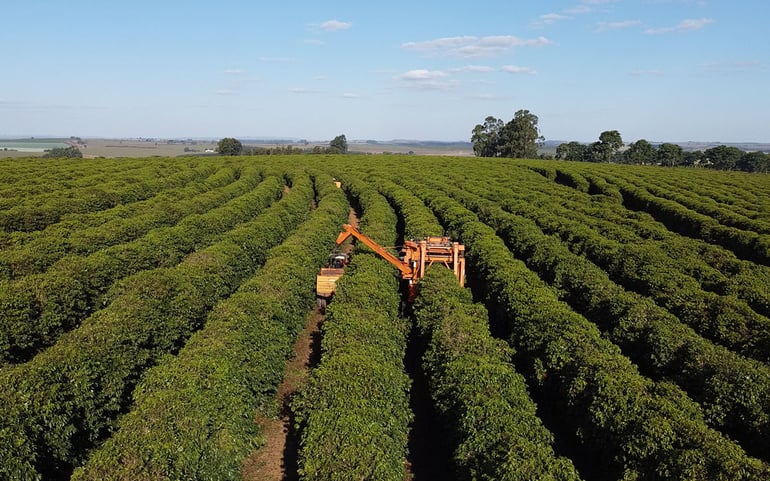
The lone harvester at Fazenda Estrela belonging to the Vinhal family (Photo: Vinhal Cafés)
But this year it seems like the odds are in his favour. Rafael says that uniformity was affected by having multiple flowerings this season, but the cherry window is holding up well, allowing him to harvest without complications.
The price of fertiliser has also dropped. Brazil’s nitrogen-based fertilisers come mainly from Russia. According to Allan of Sancoffee, supply chains have had enough time to reorganise themselves since the outset of the war in Ukraine and prices are nearly back to pre-war levels.
It’s important to highlight that the new fertiliser price will help reduce production costs only from 2024 onwards as the coffees being harvested now were fertilised with inputs purchased in 2023, when the cost was high.
Labour costs remain high and, unlike fertilisers, are not likely to drop soon.
Demand for Conilon is Exploding
Producers of Conilon have seen an explosion in demand over the last quarter. Cafesul says they are receiving new requests every day and that many cooperatives are turning to international markets as prices increase.
Cafesul is a small Fairtrade certified cooperative and many of the requests are for conventional uncertified coffee, but this signals a shift in demand that affects the domestic Conilon market.
Up until this year, the internal market was the biggest destination of Conilon, paying more than international buyers.
Now, the demand switched, putting extra pressure on prices as Brazilian buyers try to step up. On top of that, Cafesul expects to have 30% less volume this year because a cold spell last September led to a significant incidence of flower bud abortions.
Country-wise, the reduction in Conilon volume is expected to stay at 5%.
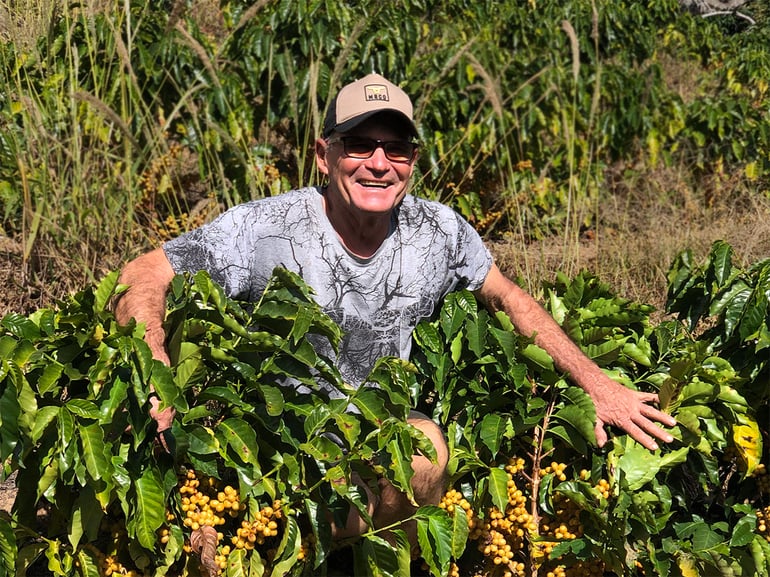 On the ground, producers and exporters believe the next five years will be good for Conilon - and they're getting prepared (Photo: Sítio dos Cedros, Farmers Coffee)
On the ground, producers and exporters believe the next five years will be good for Conilon - and they're getting prepared (Photo: Sítio dos Cedros, Farmers Coffee)
In the South of Espírito Santo, where our Conilon partners are based, uncharacteristic rains delayed the beginning of the season. The rainy period ended up just in time for producers to cover their patios with cherries, so the quality is also expected to be good.
An Easier Harvest for Roasters
Whether roasters are looking for Arabica or Robusta, it should be a lot easier to source coffee this season. “There is a lot of coffee out there,” as Bruno Antonio Franco of Fazenda Inhame and Capeca in Campos Altos puts it.
Producers’ price expectations are going through a period of adjustment. Many expected the price of a sack to remain at around RS$ 1,000.00 (around US$ 200.00) and that’s not happening.
Conab’s weekly round-up already shows bags of 60 kg being purchased for less than RS$ 800.00 (around US$ 165.00). That’s similar to Q2 2021, pre-frost.
Bruno also says most farmers in Campos Altos are better off financially than they were pre-frost and there is less despair to sell coffee at any cost, which helps to explain why trading has been slower on their side.
Exporters have also been more cautious. Many suffered losses in 2022. Traders with long strings (long positions, where contracts had to be delivered at a date far ahead in the future) were particularly affected as they had to fulfil existing contracts with costly coffees.

For Roberta of Itah (right), Brazil was "out of the game" in 2022, when buyers wouldn't even discuss the prices they had to offer (Photo: Algrano)
It’s no wonder roasters could, at times, still find “more affordable” Brazils on the spot market. Now, the same traders are taking much less risk, selling first and then buying.
All in all, Brazilian producers and exporters are seeing a return to business as usual. Their medium to long-term expectations is that prices will remain on the lower side and might even drop further the closest we get to 2024’s harvest.
In such times, producers with roaster partnerships tend to be more insulated. For buyers, this means farmers will be more willing to come to the negotiation table. It will be easier for cooperatives to originate coffee and the price incentive for specialty coffee becomes more relevant once again.
It’s a buyers’ market.
Brazilian Coffee on Algrano
Harvest: May - September
Offer period: July - March 2023
Shipment: August - April 2023
Warehouse release: From October
The featured photo shows Fazenda Samambaia by Sancoffee.
Thank you to our partners at Sancoffee, Vinhal Cafés Artesanais, Itah Café, Capeca, Fazenda Inhame, Fazenda Canta Galo, Farmers Coffee and Cafesul for all the insights needed to write this report.




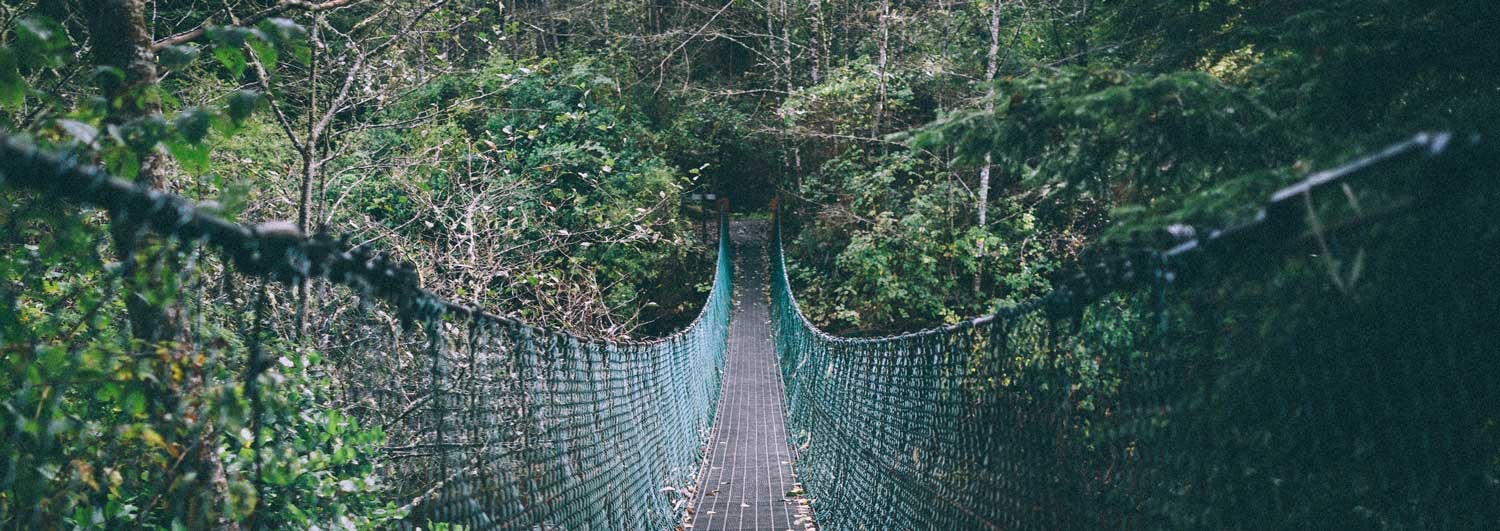
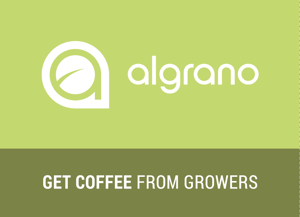
Let Us Know What You Thought about this Post.
Put your Comment Below.